[ad_1]
Three weeks ago, I shut down my trusty Microsoft Surface 2-in-1 to embark on a daring experiment – using an Android tablet as my primary computing device. More specifically, I mean using the Samsung Galaxy Tab S8 as my sole work machine. It might sound outlandish, but to my surprise, I came out with a mostly positive experience.
Yes, there were a few frustrations, but the Galaxy Tab S8 gave me numerous reasons to believe that Android tablets are not the lost cause that many out there think. The Android tablet experience is surprisingly strong in 2022, and I hope things continue to improve in the years to come. Here’s how and why I stuck with the Galaxy Tab S8 for weeks without losing my sanity.
Where the Galaxy Tab S8 shines

There’s a lot to like about the Galaxy Tab S8, both from a software and hardware perspective. An 11-inch tablet might sound too small to serve as one’s sole workstation, but coming from a 10.5-inch screen offered by the Microsoft Surface Go 2, it was still an upgrade to me. Plus, the wider aspect ratio of the Galaxy Tab S8 ensured that the split-screen view felt more natural, unlike the cramped mess of Surface Go 2’s tall 3:2 screen.
The pixel-dense 2560 x 1600 screen was a welcome upgrade, and even though it wasn’t as vibrant as the OLED panel on Galaxy Tab S8+, the sharpness and brightness were still much better. It helps that the Samsung tablet is thinner and lighter than its Windows counterpart and extremely close to the iPad Air 5 on the parameters above.
A healthy number of features gave the Galaxy Tab S8 an edge over Windows machines. For example, with a few taps, it turns into a pixel-dense secondary display for a PC without any dedicated apps or cables. The speakers are balanced and produce a crisp sound, while the battery easily supports a day’s worth of work.
With Nearby Share, you can transfer files between your phone and tablet at a blazing-fast speed, and 5G connectivity is another practical benefit over a Windows PC or Mac. Samsung has also guaranteed four years of Android OS upgrades and security updates for five years, which is a massive bonus for longevity and unparalleled in the Android ecosystem.
Samsung’s software steals the show
To save you the shock of moving from a desktop UI to a poorly stretched Android phone UI on the tablet, you get the excellent DeX mode. I felt right at home with the Windows-like design approach. Plus, window resizing in DeX mode is quite rewarding and fluid. Resizing is smooth, and floating windows are a joy to work with.
As far as Chrome goes, the context menu that appears after selecting text on Android can pull up web search results and translation in a pop-up view on the same page instead of a new tab, as is the case while using Chrome’s desktop version. It’s a neat advantage, and here’s how it kicks into action:

One UI supercharges the experience at this point. Irrespective of whether you are in DeX mode, the excellent side panel lets you quickly access your most frequently used apps with a single swipe gesture. But it can do a lot more. You can stack GIF creation and screenshot tools, too. Core tasks (alarm, messages, calendar entry, etc.), weather information, contacts, clipboard, and reminders are all just a swipe away. It is deeply customizable as well.
There’s also no need to remember shortcuts, unlike on PC or Mac. The S Pen quick commands and air gestures add a whole new dimension of convenience. Plus, the S Pen is one of the best stylus options you can find out there, not just in terms of sheer fluidity and low input latency, but the customizability at its heart is also noteworthy. Once you get used to the combined tricks of edge panel and S Pen shortcuts, it’s hard going back to the keyboard and mouse system of a PC.
I often found myself tapping the non-touch-sensitive screen of my Asus Zephyrus laptop every time I returned to it for playing games, and sorely missed the stylus convenience whenever I moved away from the Galaxy Tab S8. Yes, it takes some time to get used to the stylus as the input method, but once I got used to it, I didn’t feel the need for a mouse or trackpad. I did miss the multi-finger gestures offered by a laptop’s trackpad, but the Alt + Tab combo and Android’s navigation bar gestures made up for it.
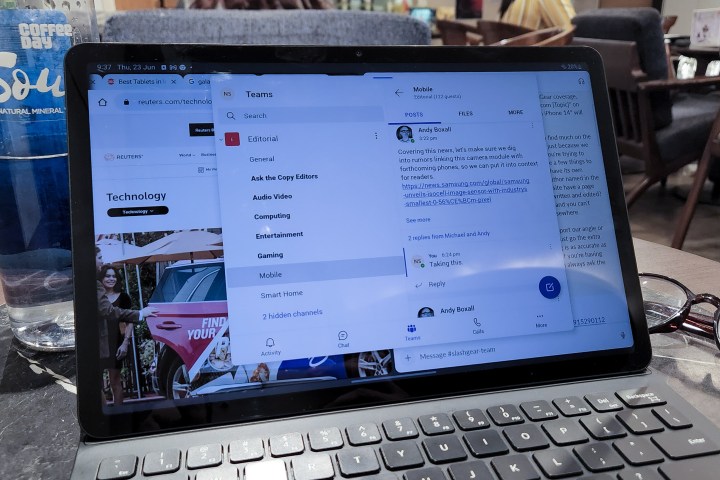
Adobe Photoshop Express proved to be more than enough for my image-editing and retouching needs. I also tried Canva alongside a few other editing apps, and the Qualcomm chip inside Samsung’s flagship tablet handled them easily, without any throttling or fan noise. Even with 20 or more apps running in the background, the Galaxy Tab S8 never felt laggy. My Windows laptop with an AMD Ryzen chip and Nvidia graphics stutters when I push Chrome too hard.
The instant unlock-to-resume experience on the Samsung tablet proved to be another welcome surprise. There’s a reason Intel makes such a huge deal about the “instant wake” experience on PCs that come with the Evo badge slapped on them. The Galaxy Tab S8 lets you dive back into your work without delay, faster than even Intel Evo-certified Windows 11 machines.
Surpassing the PC experience
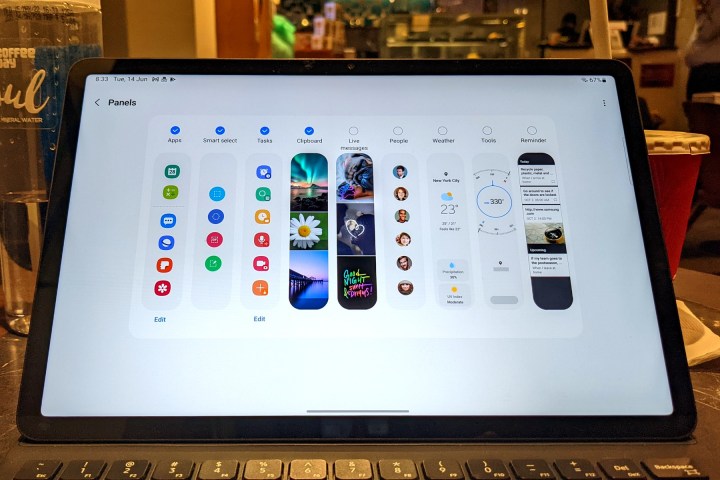
In fact, there are a few more things that the Galaxy Tab S8 does better than a Windows PC. For example, window management is much smoother, especially with the stylus. Plus, you can adjust a window’s transparency and always keep it in your view instead of minimizing it. The drag-and-drop gesture for opening the third app from the edge panel in a 2:1:1 view is also quite convenient.
Plus, the 4K-ready 13MP main and 6MP ultrawide camera array is a neat addition. Even if you don’t use the cameras to take photos and videos, AR solutions like Quick Measure are handy tricks you won’t find on a Mac or Windows PC.
Being an Android device, you get all the bells and whistles that come with Google’s latest OS version — plus a few extra perks courtesy of One UI. The ability to answer calls and handle messages when connected to a Samsung phone was also a huge bonus for me, as it kept me from picking up my phone for calls and then getting distracted by Instagram or Twitter notifications.
I did squeeze in a few sessions of Diablo Immortal from time to time, but I did that for research purposes, I swear!
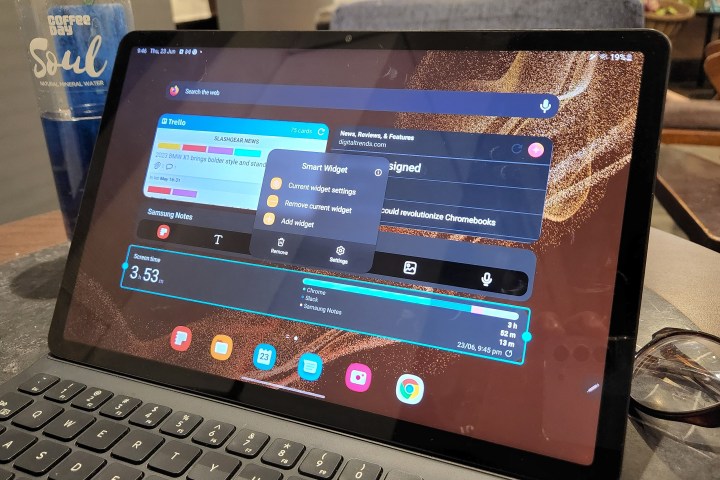
For my work and academic needs, I didn’t encounter a scenario where I felt kneecapped after switching to the Galaxy Tab S8 as my primary computing machine. Where apps didn’t work, I lived with their web client. With plenty of power to boot, a convenient form factor, and healthy battery life, the Galaxy Tab S8 truly changed my perception of its ability to be a serious computing machine.
While the debate rages over Apple turning the iPad into a computer, Samsung has already done that for me with the Galaxy Tab S8. That’s no small feat, as the experience was truly an eye-opener. However, that doesn’t mean the Galaxy Tab S8 will do the same for everyone.
Android tablets still aren’t perfect

Of course, there are annoyances, but most have to do with the bad shape of Android app optimization for tablets. Even Google’s core apps, despite the company’s renewed focus on tablets, have a handful of shortcomings. Take Chrome, the backbone of my workflow. Compared to its desktop client, the Android version doesn’t let you create tab groups. You can’t drag and drop tabs between two Chrome windows either.
The biggest limitation was the inability to use Chrome extensions, especially the utilitarian extensions that I can’t live without (such as Grammarly, character counter, Adobe Acrobat, Image Downloader, and Keepa for checking product price history, among others). You’re also limited to running up to five Chrome windows, only two of which can run in split view, while the rest can be used in the pop-up view. It’s still better than what an iPad can do, but nowhere close to a PC experience.
And this extends to non-Google apps, too. A majority of applications simply run as a stretched-out mobile view and look terrible. While the likes of Slack, Microsoft Teams, and Trello make great use of the extra screen real estate, Asana is downright abysmal. Your best option is to run the web client in desktop mode for a less infuriating experience.
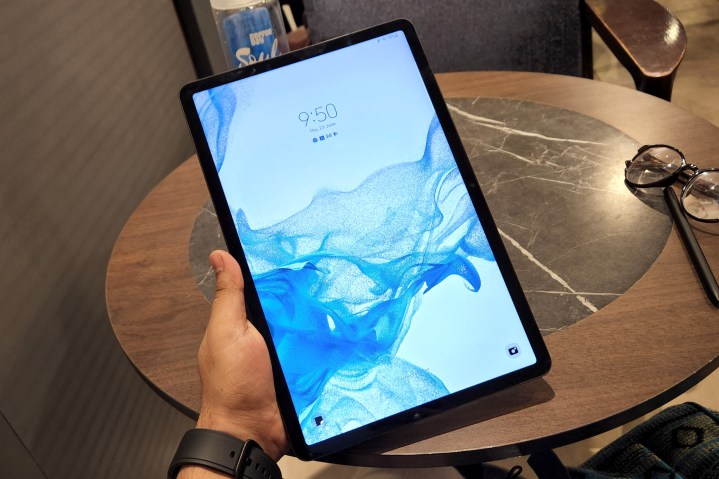
If you’re a power user, a bunch of heavy-duty editing apps are simply not available on Android. Not that you’d want to do 4K video editing on an Android tablet, but a top-shelf chip like the Snapdragon 8 Gen 1 should be pushed, especially for all the money it commands. I did try some media-editing apps, but they’re brimming with a frustratingly high amount of ads, or lack some of the versatility offered by apps tailored for Windows or Mac.
The Tab S8 isn’t cheap, but it delivers
It’s pretty apparent that turning an Android tablet into a full-blown work computer is an expensive endeavor. That’s because high-end Android tablets can only offer a computer-like experience if you invest in the peripherals like folio keyboard cases, and a stylus, if possible. And trust me, despite how unintuitive it might sound, using a stylus really makes a difference.
I did miss the convenience of a mouse, especially the right-click gesture to access some key functionalities, but once you get used to a capable stylus – of which there aren’t many aside from Samsung’s S Pen – there is no coming back. However, those accessories don’t come cheap. Even the basic keyboard folio for the Galaxy Tab S8, despite lacking a trackpad, will cost you $140.

Assuming you seek the full laptop experience after shelling out over a thousand dollars on the Galaxy Tab S8 Ultra, you’ll have to spend another $350 on its keyboard folio. That’s a lot of money, enough to buy a fancy mechanical keyboard, a Chromebook, a refurbished Windows laptop, and even an Android tablet like the Xiaomi Mi Pad 5 that comes with a flagship-tier processor.
But if you can afford the cost of turning a sleek OLED tablet like the Galaxy Tab S8+ or its Ultra sibling into your work machine with its own unique set of advantages over a laptop or desktop, you won’t be disappointed. Google is also trying (again!) to care about Android tablets with some key UI optimizations in Android 12L and Android 13, which instills hope that Android tablets are finally on the right path.
With some help from Samsung’s own attention to detail in One UI, I am hopeful that Android tablets like the Galaxy Tab S8 are ready to take over your computing needs for both work and entertainment. Just make sure that you go through a SWOT analysis before nuking your wallet.
Editors’ Recommendations
[ad_2]
Source link





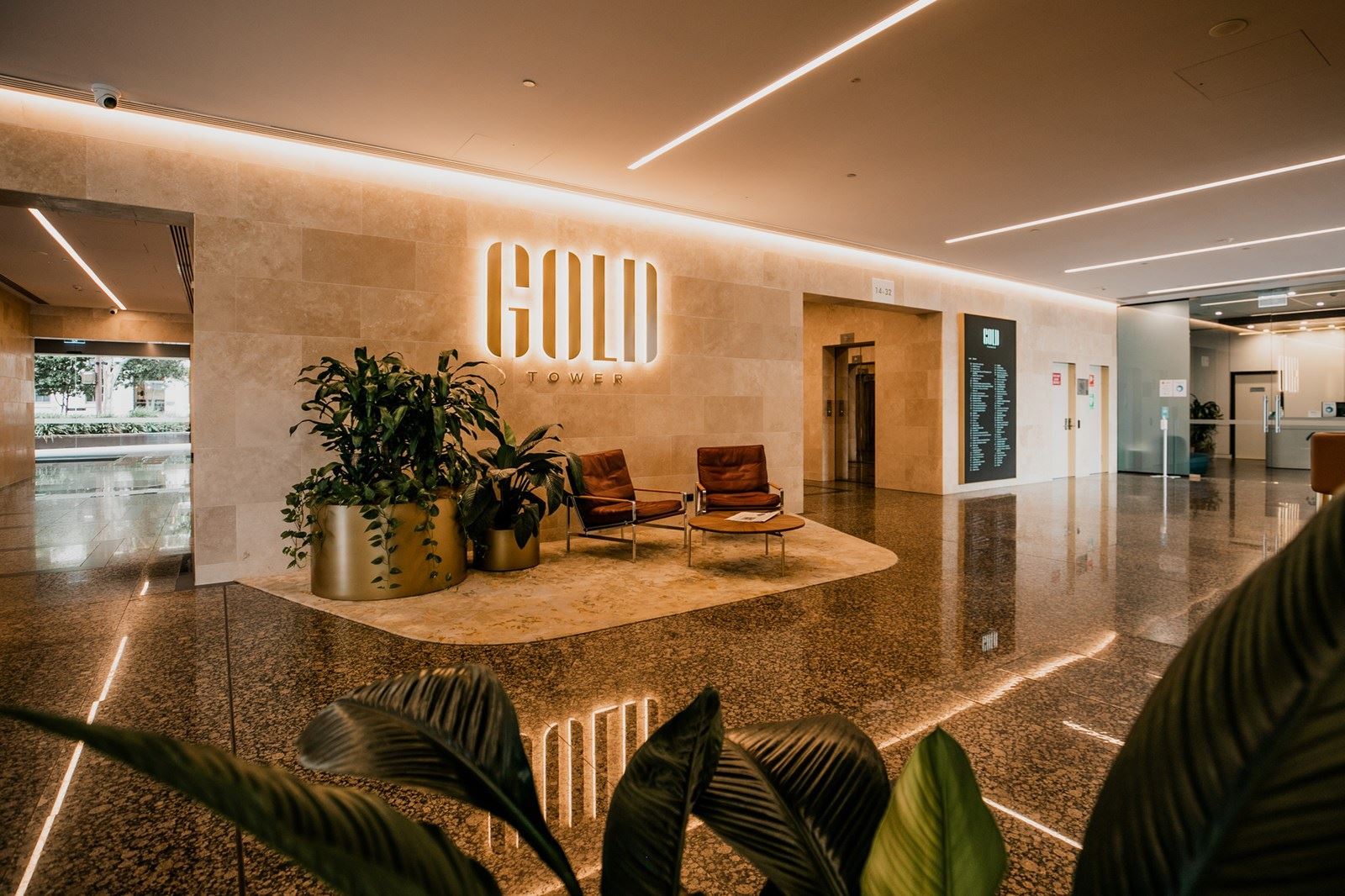



More Stories
Authentic Mobile Reviews – What Is the Advantage?
8 Tips for an Agile Debugging of a Web Application – Grape Up
Report: Apple planned to launch an iPhone-compatible Pencil this year